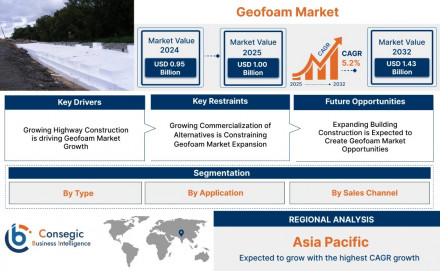Geofoam Market: Key Players and Investment Opportunities (2025-2032)

Geofoam Market Size:
The geofoam market size is growing with a CAGR of 5.2% during the forecast period (2025-2032), and the market is projected to be valued at USD 1.43 Billion by 2032 from USD 0.95 Billion in 2024. Additionally, the market value for 2025 is attributed to USD 1.00 Billion.
Geofoam Market Introduction:
Geofoam is a lightweight, engineered foam material used primarily as a geotechnical fill in construction and infrastructure projects. Typically made from expanded polystyrene (EPS) or extruded polystyrene (XPS), geofoam offers a low-density alternative to traditional fill materials like soil or gravel. With its unique properties such as high compressive strength, low thermal conductivity, and ease of installation, geofoam is utilized in road embankments, bridge abutments, retaining walls, and slope stabilization. The demand for geofoam is increasing due to the rising need for cost-effective, space-efficient, and durable construction materials in both developed and developing regions.
Geofoam Market Overview:
The global geofoam market has witnessed steady growth in recent years and is expected to continue expanding at a significant rate. This growth is driven by increasing infrastructure development, particularly in urban areas, as well as the material’s suitability for use in challenging construction environments. According to recent market estimates, the geofoam market is projected to grow at a CAGR of over 6% during the forecast period. The market encompasses a range of applications across civil engineering, including road and highway construction, airport runways, railway embankments, and foundation repairs. North America currently dominates the market due to widespread adoption of modern construction materials, followed by Europe and the Asia-Pacific region.
Geofoam Market Includes Drivers, Restraints & Opportunities
Drivers:
Infrastructure Modernization: One of the primary drivers of the geofoam market is the growing global emphasis on infrastructure modernization and expansion. Urbanization and the need to rehabilitate aging infrastructure are creating significant demand.
Advantages over Traditional Fill: Geofoam is lightweight, which helps reduce the load on underlying soils and structures. Its ease of handling and fast installation process reduces labor costs and project timelines.
Sustainability and Environmental Concerns: Geofoam can be manufactured with recyclable materials and offers energy-efficient insulation properties, making it attractive for green building initiatives.
Geotechnical Applications: Its superior performance in soft soil conditions, seismic zones, and areas with limited accessibility enhances its attractiveness for complex geotechnical projects.
Restraints:
High Initial Costs: The upfront cost of geofoam materials is relatively higher than conventional fill materials, which may deter adoption, particularly in cost-sensitive markets.
Environmental Concerns Related to Polystyrene: Despite its benefits, geofoam is primarily made from petroleum-based polystyrene, raising concerns about long-term environmental impact and disposal challenges.
Flammability and Chemical Sensitivity: Geofoam materials may degrade when exposed to certain solvents and are flammable unless treated with fire retardants, limiting their usage in certain applications.
Lack of Awareness: In emerging economies, the lack of awareness and technical knowledge about geofoam applications hampers market penetration.
Opportunities:
Emerging Economies: Rapid infrastructure growth in Asia-Pacific, Latin America, and Africa presents major opportunities for geofoam adoption, especially in road and railway construction.
Product Innovation: Opportunities lie in the development of fire-resistant, eco-friendly, and more cost-effective geofoam variants, which can help address current limitations.
Public Infrastructure Investment: Increased public spending on transportation infrastructure, flood control projects, and urban development is likely to boost geofoam demand.
Sustainable Construction: Rising popularity of green building certifications and energy-efficient structures offers room for growth in environmentally sustainable geofoam solutions.
Geofoam Market Competitive Landscape Analysis (Key Players)
Carlisle (United States)
Amvic Building Systems (Canada)
Expol (New Zealand)
Pacific Allied Products, Ltd. (United States)
Plasti-Fab Ltd. (Canada)
Atlas Roofing Corporation (United States)
Insulation Company of America (United States)
Foam Products Corporation (United States)
Jablite (United Kingdom)
ThermaFoam, LLC (United States)
Geofoam Market Industry Segmentation:
By Type
Expanded Polystyrene
Extruded Polystyrene
By Application
Road & Highway Construction
Airport Runways and Taxiways
Rail Embankment
Building Foundations
Others
By Sales Channel
Direct Sales
Indirect Sales
By Region
Asia-Pacific
Europe
North America
Latin America
Middle East & Africa
Regional Analysis of the Geofoam Market:
North America: Holds the largest market share due to extensive infrastructure rehabilitation, stringent building codes, and early adoption of advanced construction materials. The U.S. leads in terms of demand and technological advancements.
Europe: Witnesses strong growth driven by environmental regulations, energy-efficient construction initiatives, and infrastructure projects across countries like Germany, the UK, and France.
Asia-Pacific: Poised for rapid growth due to increasing urbanization, industrial development, and large-scale public infrastructure projects in countries such as China, India, and Japan.
Latin America and Middle East & Africa: These regions are in early stages of adoption but offer long-term growth potential due to government-backed infrastructure initiatives and foreign investments in construction.
Geofoam Market Recent Developments:
Product Advancements: Companies like Atlas Roofing and Jablite have introduced flame-retardant and recyclable geofoam solutions to address environmental concerns and enhance safety.
Strategic Expansions: Several players have expanded their manufacturing units in North America and Asia-Pacific to meet rising regional demand.
Collaborations and Joint Ventures: Key players are entering partnerships with construction firms to promote geofoam use in public infrastructure.
Regulatory Approvals: Governments are increasingly including geofoam as a standard solution in construction codes, which is helping increase market adoption.
Contact us:
Consegic Business intelligence Pvt Ltd.
Contact no: (US) (505) 715-4344
Email: sales@consegicbusinessintelligence.com

